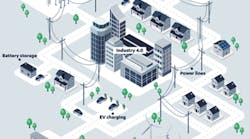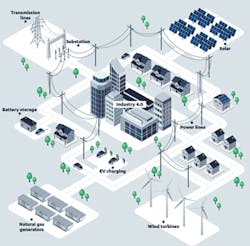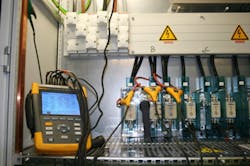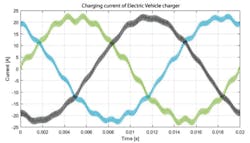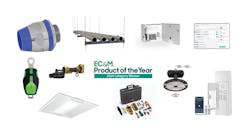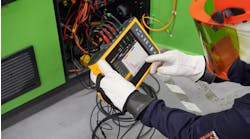Although not nearly as exciting as extra-terrestrials that may threaten our planet one day, there are existing threats to the quality of our power grid. Non-linear loads – fluorescent and LED lighting and variable-frequency drives (VFDs) – have been causing damage to electric power systems for many years. These types of loads are commonly the source of lower frequency harmonics (i.e., 3rd (180 Hz), 5th (300 Hz), 7th, 9th, etc.) – multiples of the fundamental frequency (60 Hz in the United States).
Typical rotating induction or synchronous generators produce voltage and current at the fundamental frequency (60 Hz). More modern generation equipment, including power-electronic-based switching inverters or converters used in wind, solar, etc., produce 60 Hz AC through high-frequency switching, in the conversion from DC to AC, and the sinewave we would expect is impressed upon with multiples of the fundamental frequency in much smaller amounts — otherwise known as harmonics.
Non-linear loads can also inject harmonic higher frequency currents back into the electrical power system, whether it is the customer’s facility or the power grid. A few examples include VFDs, LED lighting, process/computer equipment, and electric motors driven by inverters. VFDs take in the 60 Hz AC voltage and current to convert that into DC and then create a variable-frequency output so that the motors can be controlled more precisely and in a more efficient manner.
Standards such as IEEE 519-1992, IEEE Recommended Practices and Requirements for Harmonic Control in Electrical Power Systems, set limits for the harmonic multiples that are acceptable up to and including the 35th harmonic (2,100 Hz).
But what about frequencies above those levels? Renewable energy generators with power-electronic switched-mode generators are a newer technology that has the possibility to generate harmonics in even higher frequencies — in some cases from the 35th to the 2,500th harmonic (2 kHz to 150 kHz), which are termed “supraharmonics.”
The long-term effect of supraharmonics isn’t fully understood, as research is limited to date. In addition, many traditional measurement tools are not able to measure these higher frequencies. Higher-end power quality meters (Fig. 2) can measure up to 10 kHz for low-voltage systems (<600VAC). Technology for measurements of high-frequency harmonics on medium-voltage cables and equipment lags behind.
Grid-connected solar power plants and small wind power plants are connected to the distribution network through pulse-width modulation (PWM)-controlled power converters. They inject harmonics and supraharmonics at the point of common coupling (PCC) while injecting active and reactive power into the existing network. Static power converters used in variable-speed control of wind turbine generators are one source of supraharmonics. Technology used to improve the stability of the grid are also a source of supraharmonics. The voltage-source converters used in flexible AC transmission systems (FACTS), static synchronous compensators (STATCOMs), dynamic volt-amp reactive systems (D-VARs), and other devices having switching frequencies in the kHz range are sources of supraharmonics.
Potentially, all of these items could be a source of these high-frequency harmonics.
- Active rectifier loads and switch-mode power supplies
- Active front-end (AFE) drives
- Electric vehicle (EV) charging stations and other battery chargers
- PCs, LEDs and other lighting, consumer electronics and other household equipment, especially power factor corrected (PFC) equipment
- Inverters used in alternative energy systems
- Solar photovoltaic (PV) systems
- Wind turbines
- Battery energy storage systems (BESSs)
- Uninterruptible power supplies (UPSs)
- Active harmonic or power filters (AHF or APF)
A recent study of wind farms in Sweden noted visible supraharmonics up top 150 kHz (Fig. 3) from Evaluation of Medium Voltage Network for Propagation of Supraharmonics Resonance, Department of Engineering Sciences and Mathematics, Luleå University of Technology, Sweden.
What are some of the possible negative effects of these high-frequency harmonics:
- Overheating of capacitors, which can lead to failures.
- Distortion or failure of energy meters
- PLC (proportional logic controller) communication issues and interference
- Overheating and possible damage to medium-voltage cables and terminations
- Thermal stress on connected equipment
- Power interruptions
But what if you don’t work with PV or wind farms or live anywhere near them? Do you need to worry about supraharmonics? Yes, you do. There are many other types of high-frequency switched power supplies used in the conversion from AC-DC, and vice-versa. Ever hear of EV car chargers, which will soon be located outside every business and in every parking lot and driveway?
Figure 4 provides an example of the currents required by a charger for an electric car, with high frequencies visible. The switching frequency used for EV chargers is around 10 kHz. This also results in the presence of currents with a frequency that is a multiple of this number (e.g., 20 kHz, 40 kHz, etc.).
In summary, higher frequency harmonics will be a concern in the future with our modern power grid, and more research, better tools, and new mitigation techniques will be needed.
David Colombo, P.E. is a professional engineer located in Massachusetts, and the owner and principal of Power Engineers, LLC, a design, engineering, and consulting firm. He has more than 30 years in the electrical engineering and construction industry and is involved with the design of utility substation & distribution infrastructure, large-scale renewable energy projects, and commercial / industrial power systems. He specializes in the areas of medium-voltage design, power distribution, protection, metering, power quality, power studies, and arc flash analysis. He also provides owner’s engineering support for developers, EPC contractors, and project owners. Prior to starting Power Engineers, LLC and being an engineering consultant, he was a utility distribution supervising engineer. He holds a bachelor of science degree in electrical engineering from Worcester Polytechnic Institute (WPI) and a master of engineering degree in electric power engineering from Rensselaer Polytechnic Institute (RPI). He is a registered professional engineer in 13 states.
